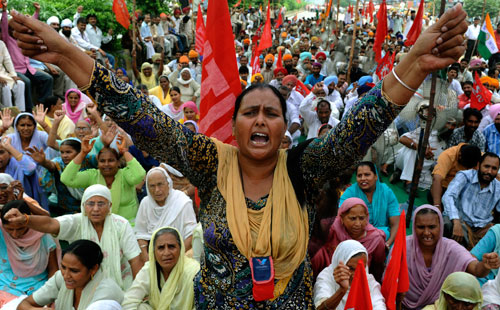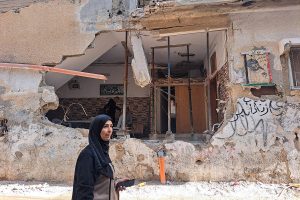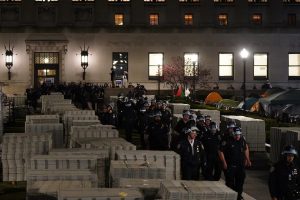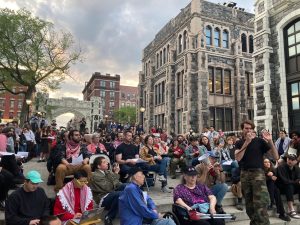Photo by NARINDER NANU/Getty Images
Between 1991 and 2015 there is a vast gap. The mainstream left parties and the Central Trade Unions and other mass organisations affiliated to them had at that time a much tighter grip on the working people. But they were becoming utterly clueless in a world where the Tien-an Men Square massacre had occurred, where the East European bureaucratized workers states had taken the path of capitalist restoration and even the Soviet Union was about to collapse. The Stalinist ideology and politics most of these parties followed was in its death throes. On the other side was the decades long class collaborationist practice in independent India. This was the time when the BJP had begun its ascent, over the campaign to destroy the Babri Masjid.
As a result, in the belief that resisting fascism demanded an alliance with the so-called democratic sections or the anti-fascist sections of the bourgeoisie, they were not willing to take up the fight against the first round of neo-liberal offensive seriously. Indeed, frozen in their doctrinaire position that India needed a two-stage revolution and that globalization was the imposition of imperialism, they did not even realise how much the new policies were brought about in the interests of the Indian ruling class itself. The capitalists globally made no such mistake. A World Bank report at that time said that unlike in many other countries, in India they did not meet with hostility from government bureaucrats and banks when they put forward their Structural Adjustment proposals, but were instead met with similar proposals from the opposite side. This simply means that the Indian capitalist class had decided that further capital accumulation needed a great deal of economic liberalisation. Those leftists who were busy hunting for the “progressive national bourgeoisie: were the ones who did not understand this.
And of course, from 1992, what took priority was the “anti-communal, secular united front”. In practice, this meant tolerating Narasimha Rao’s neoliberal and soft Hindutva tinged government as the “lesser evil”. This was the first step in a series of disastrous actions. They followed this with support to the United Front, a government propped up by the Left and with the CPI actually participating in the cabinet. But the economic policy of this government was crafted by P. Chidambaram. His budget was hailed by Indian big capital as a “dream budget”. It was frustration at the failure of the United Front no less than anger at the Congress that resulted in the Vajpayee –led National Democratic Front government coming to power. The policies of the NDA government resulted in tremendous popular disaffection, and this resulted in the electoral results of 2004, when the Left won its greatest ever share of votes and seats. The four left parties polled nearly 9 per cent of the votes and obtained 62 seats. But they then declared support, once again, to the Congress-led United Progressive Alliance, and broke only four and a half years later over the nuclear treaty with the USA. Neither was that a principled anti-nuclear stand, since the objection had more to do with : “why the USA?”; nor did they tack opposition to the economic policies of the government. Indeed, in places like West Bengal, where they were in power, they followed the same neo-liberal policies.
There are important changes today. On one hand, in the Indian parliament, the left parties have far less representation than they had in the past. Within the working class movement too, their ideological as well as organisational control has gone down. Today, the RSS dominated BMS is the biggest union, followed by the Congress led INTUC. Meanwhile an entire generation of working class has grown up. Workers are losing jobs. Masses of workers are finding permanent jobs being converted to contract jobs. As a result, tremendous pressure is coming up from within the working class, demanding resistance. Between 1991 and 2006, in the nationalised sector, there has been a loss of 8,70,000 jobs. Between 1991 and 2013 there have taken place sixteen one or two day all India strikes. The ones in 2010, 2012 and 2013 were big events in the second phase of the UPA government.
Pressure is welling up for struggle, and for unity to wage struggle. The long struggle in the tea gardens was made possible by the unity. In jute mills, in the hosiery industry, there have emerged common platforms. That the INTUC and the BMS also had to go against their own governments is an indication of the working class pressure. [On 30 August the BMS finally withdrew its support for the strike, making it easier for the government to apply the harsh anti-labour, anti-strike measures it has been threatening to use in case the strike does take place.]
But there are many revolutionary organisations and their cadres who will say that the limitations of these struggles have been repeatedly shown up. This is where we need to test, what is a real revolutionary strategy, what are revolutionary tactics. And who are the people who only shuttle between reformism and sectarianism. For, when the working class movement has been taking severe beatings, and is on the backfoot, when the revolutionary organisation/s and movement is weak, to expect in such a situation that the bulk of the trade union movement will be revolutionary is to indulge in utopian day-dreaming. And if revolutionaries, in the name of retaining their “purity”, refuse to get involved in serious struggles, if they think that their task is to stand by the roadside passing out leaflets criticising the reformist lines of the Central Trade Unions, then history will move forward, leaving them behind.
We have said, in the first article, that the working class is contesting a government holding the banner of fascism. This is not an easy struggle. But this struggle cannot but begin through organisations that the working class is familiar with, organisations that they see (even if erroneously) as organisations standing by them for their struggles. And the enemy is not one company, one enterprise, but the entire ruling class and its political organisation – the state. A fitting response can be given only at the all India level, hence the oft used critical comment – “only a one day strike is not enough”, is only a partial truth.
If revolutionaries think their task is to ultimately win over the majority of the working class to their perspectives, then they have to act as organisers of working class struggles in a big way. Formally everyone or most will agree with this. But in practice, as the struggle in the tea gardens showed, the task is difficult. An immense amount of energy must be spent in seriously building trade unions and going to a militant struggle. And then, at need, one has to call traitors as traitors. This is what happened in the tea gardens. But only when the revolutionaries were fully involved in building the struggle will they gain a hearing if they call the reformists by their proper names. Only through such struggles can they successfully build, not miniature pocket unions led by a “revolutionary party”, but democratic working class unions.
What the one day all India strike can do is raise the crucial issues before the workers of the country. The added duty of revolutionaries is to raise the long term issues within every partial struggle. For example, we can say, in the case of the tea garden struggles, which ended with the shameful capitulation of the major unions to the dictations of the owners dressed up as government announcement at the tripartite discussions, it is not enough to castigate the capitulations. It is also necessary to hold up the alternative. In the same way, we can say that when the All India Federation of University and College Teachers’ Organisations (AIFUCTO) or the West Bengal College and University Teachers’ Association demand pay rise or Dearness Allowance and yet do not mobilise seriously, our task is to get in there, demand greater mobilisations, and insist that the rights of the masses of part time teachers be highlighted.
The most vital task in today’s situation is to organise the vast masses of unorganised workers. To do this, revolutionaries must act both inside and outside unions. The limitation of any trade union is, it must begin by thinking of its own membership. But that action, however natural and even legitimate, means the exclusion of a lot of others. That is why, the traditional unions in particular, routine-bound, often bureaucratised, paid so little attention to the rights of the unorganised. But if one excludes the unorganised contract workers, then very few major struggles can achieve victory today. Bank employees understood this well enough, as banks constantly improved the ATMs so that a great many functions can be carried out through them. As this happened, the effectivity of bank strikes were blunted when ATMs remained open. So an intelligent union membership will, in its own interest, try to organise the unorganised in their own sector. But when it comes to the country as a whole, this is clearly the task of a political leadership. It is the revolutionary activists and their organisations, working hand in hand with the newer, more militant trade unions, who will begin to create the structures of alternative organisations. They have to deepen the campaigns over the strike, linking the local with the all-India demands and issues.
Over a century back, Rosa Luxemburg explained that the Mass Strike is not an isolated incident but the central aspect of the class struggle of a whole period. She saw a one day token strike as less important. More important was the blending of political and economic struggles, each inspiring the other.
Only in a revolutionary period, when the foundations and walls of class society tremble, do the vast masses of workers, including those who till the other day had been inactive, get into the thick of battles. We are certainly not in such a situation today. But nor are we in the situation of 1991, when gloom and doom had influenced the leaders of unions and parties. A considerable part of the working class has shown, through local battles as well as through participation in previous all India strikes, that they are nearing the boiling point and want to fight back. Our task is to build a revolutionary proletarian alternative. And that can only be done if we stay at our posts, and combine the struggles over local issues with the all India demands. When we take the line of building small “ideal” unions of usually miniscule size, or when we stand outside the real struggles, handing out leaflets to militant workers explaining why their leaders are traitors and agents of the ruling class, we are seen rightly by the workers as sectarians who are not involved in their real struggles.
But another temptation before revolutionaries is to apply the united front tactic badly or in a wrong way. Thus, today, the CPI(M) and its mass fronts, including the CITU, are taking questionable political positions. They have routinely poured cold water when workers have become militant. Their politics even now is one where they are desperately looking for an alliance with the Congress and other bourgeois parties in order to block the Trinamul Congress in West Bengal and the BJP at the all India level. There has been no serious self criticism by the CPI(M) of its support to neoliberalism when in power. Goutam Deb’s comments, CPI intellectual Debes Roy’s article in Ei Samay, the Bangla paper of the Times of India group, all attest to their desperation to get back some share of governmental power, with no regard to any kind of left principle. At this juncture, it is one thing to fight together with the CITU on a certain day or for a certain demand. It is a very different thing when we turn that into an alliance with the CITU, or the CPI(M), as some forces on the radical left are doing. That enables the CPI(M) to present itself under “left” cover, that confuses militant cadres, and that is not really necessary to gain the hearing of the CPI(M) ranks.
Building independent movements, but not as sects outside the working class, but rather as builders of working class organisations and struggles is what is needed. Once we do so, the question of united action with reformist unions will come up. In any case whenever we are in big unions we work with cadres of those parties. It is this line, where we maintain our independence, but still work with the reformists, that needs to be worked out consistently in practice. This is the task of the revolutionary left for the 2nd September strike, not one of either finding joys that one of “our” leaders is able to rub shoulders with big union leaders in a central rally, nor in the joy of sectariana.











